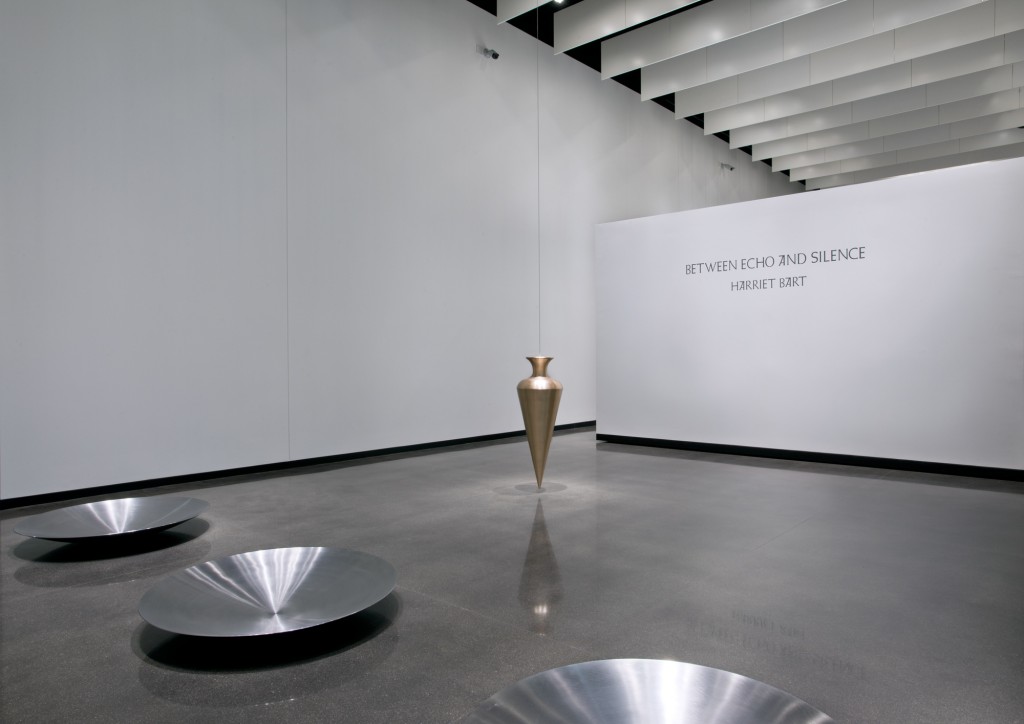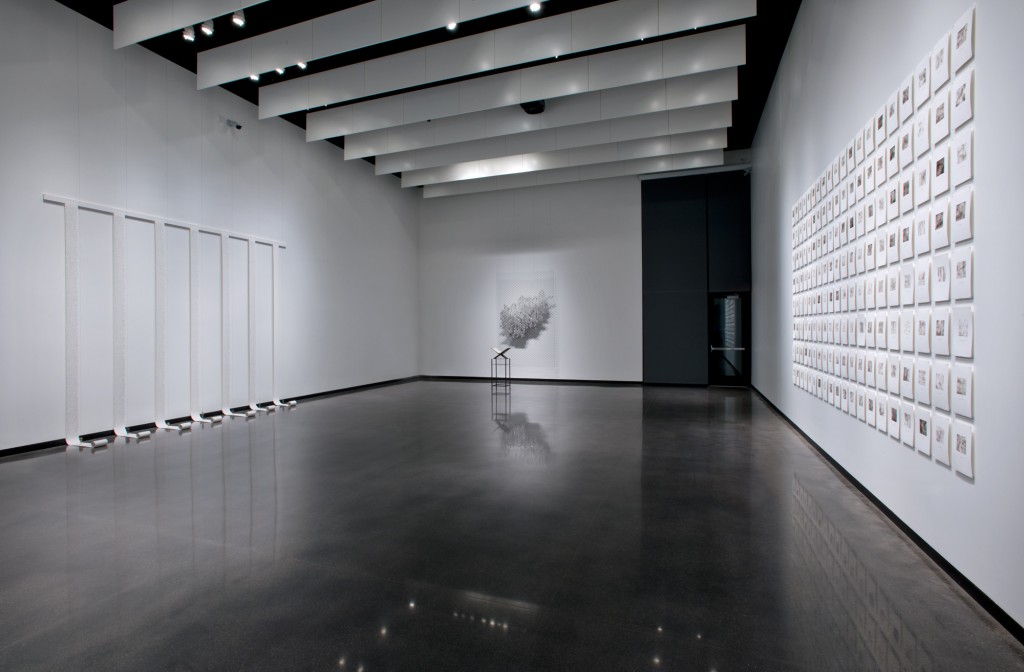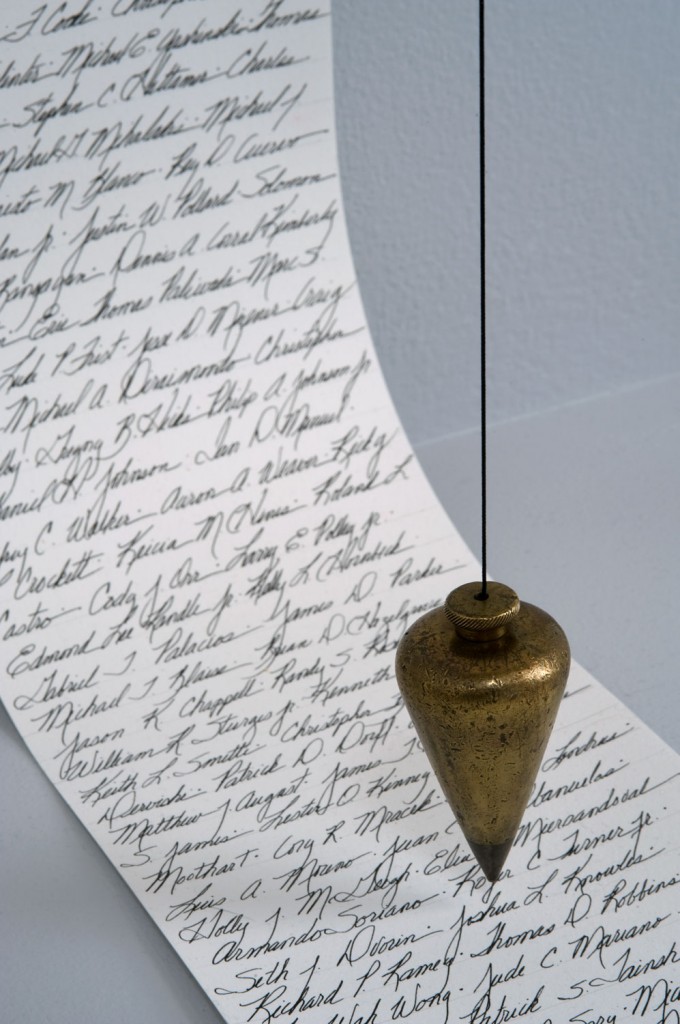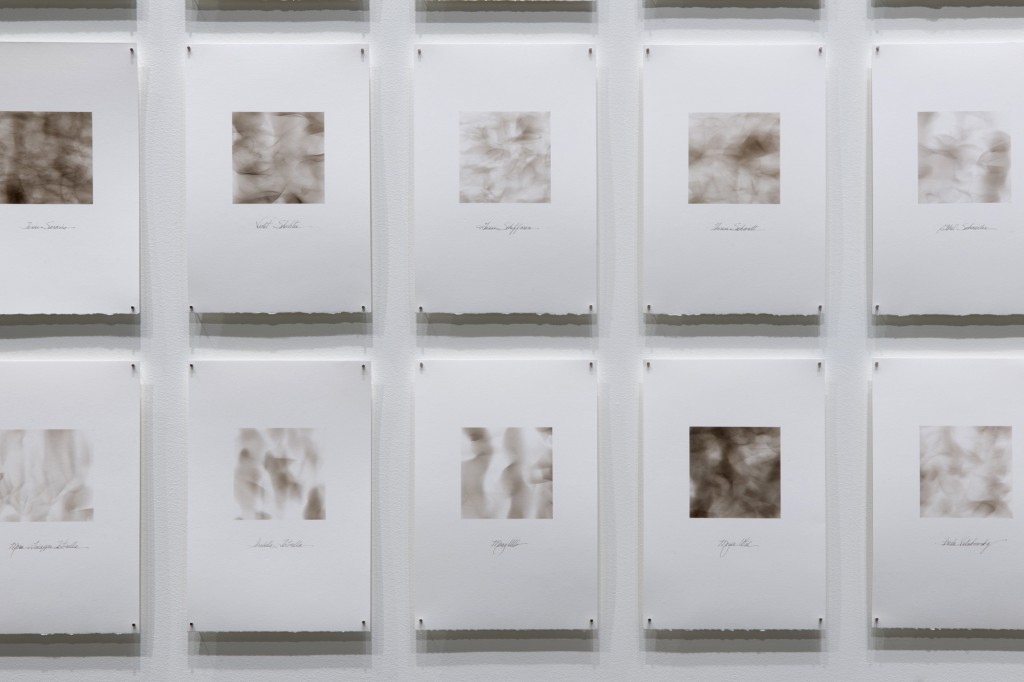
Harriet Bart’s exhibition at Macalester College on all that’s lost but not forgotten “Between Echo and Silence”
Installation view, “Between Echo and Silence.” Pictured: “Lustral Bowls” and “Pendulum” by Harriet Bart. Photo courtesy of Macalester College
Harriet Bart’s “Between Echo and Silence” is the first major exhibition in Macalester College’s new Law Warschaw Gallery, situated in the school’s beautifully renovated Janet Wallace Fine Arts Center. The show is elegant and somber, an uncluttered, utterly deliberate arrangement of just six installations — aesthetically stripped-down sculptural forms and drawings which reflect on loss and tragedy, as well as the rituals of memory, both publicly shared and privately enacted, that follow.
Walk into the glass-paneled gallery entrance, and you’re immediately faced with three, wide-mouthed, carbon steel “Lustral Bowls.” Facing them and slightly off-center is a monumental cast-bronze pendulum, suspended from above. The bowls seem to be waiting, receptive, open-ended; by contrast, the pendulum is an upright declaration, a marker evincing some as-yet unnamed but defined meaning and intention.
A low-frequency sound gradually enters your awareness, on the edge of hearing at first but steadily building to a discernible thrumming, accented by repeated slow, meditative gong-strikes. A quick look at the show’s list of works confirms the soundscape is a product of the vessels before you, “played” and recorded in the artist’s studio by Christian Korab and Peter VonDeLinde.
Installation view of “Between Echo and Silence.” Pictured (L to R): “Requiem,” “Enduring Afghanistan” and “Drawn in Smoke.” Photo courtesy of Macalester College gallery
The airy gallery space beyond is dominated by two installations commemorating those killed in America’s ongoing military conflicts in Middle East. The first of these is “Requiem,” made by the artist from 2008 to 2011 in honor of the more than 4,000 American soldiers killed in the Iraq war: seven long paper scrolls unspool from high on the wall onto the floor where each is rolled and weighted by a smooth stone. A plumb bob, echoing the pendulum at the entrance of the show, hangs above each length of paper as it unfurls across the floor, as if waiting to inscribe more names. Six of the scrolls are filled with line after line of the carefully hand-scripted names of the dead; the seventh is left blank but for just-legible rule lines — a sobering reminder of the potential for still more loss of life.
Harriet Bart, “Requiem” (detail). Photo by Rik Sferra, courtesy of the artist’s website.
“Enduring Afghanistan,” along the adjacent wall, is dedicated to those killed in the war in Afghanistan. This installation includes more than 2,000 blank “dog tags,” the kind worn by all U.S. military personnel; the ID tags have been mounted to chain link on the wall and arranged according to the shape of the country of Afghanistan. According to the exhibition essay by curator Joanna Inglot, Bart placed a tag at each spot on the map where an American soldier was killed in action; as a result tags are most densely layered in regions like Kandahar and Helmand provinces where the death toll has been heaviest. It’s an arresting, unsettling topography of the cost of war in human lives, an accounting of that loss at once cold and intimate. In front of the map-in-tags rests a ledger, in which the artist has written each fallen soldier’s name; the ledger itself is held by a Koran stand, a provocative nod to the religious and cultural conflict seething beneath the surface of our nation’s military incursions in this region.
Harriet Bart, “Drawn in Smoke” (detail), smoke and ink on paper, 2011. Photo courtesy of Macalester College gallery.
Along the remaining walls are two additional installations, both reflecting on less immediate losses: “Drawn in Smoke” and “Without Words” (created with poet Helmut Lohr). The former commemorates the workers killed in New York City’s famous 1911 Triangle Shirtwaist Factory Fire; for each of the 160 garment workers, mostly women, killed that day, Bart created a grid of 160 ethereal “smoke drawings.” Her piece with Helmut Lohr is a sequence of block panels on the wall, each printed with vinyl letters, arranged in almost-but-not-quite words. Arranged in a line, the work evokes books on a shelf, or maybe plaques on a mantel; but any message they might convey is obscured by erasure and elision. It’s an eloquent illustration of the ontological weight in absence — that lacunae are not merely empty spaces but placeholders, indelibly encoded with what-once-was.
In her poetic written statement for the exhibition of sculpture and installation work, Harriet Bart writes, “these are my poems/ Odes in metal/ Elegies in smoke…” that “speak to the no end/ of things you can’t forget.”
Harriet Bart, “Enduring Afghanistan” (detail), dog tags, ball chain, chain link, vintage ledger, fine press pages, ink, Koran stand, steel table, 2008-ongoing. Photo courtesy of Macalester College gallery
“Between Echo and Silence” by Harriet Bart will be on view through November 4 in the Law Warschaw Gallery at Macalester College, Fine Arts Commons 105, 1600 Grand Ave., St. Paul. The closing reception will include “Soundings for Harriet Bart,” a poetry reading by Nor Hall and “Rain Taxi Review of Books” editor, Eric Lorberer, at 4 p.m. in the gallery on November 4. For additional information, gallery hours, and directions visit www.macalester.edu/gallery.
Recent Content
-
Artsarticle ·
-
Artsarticle ·
-
Artsarticle ·




